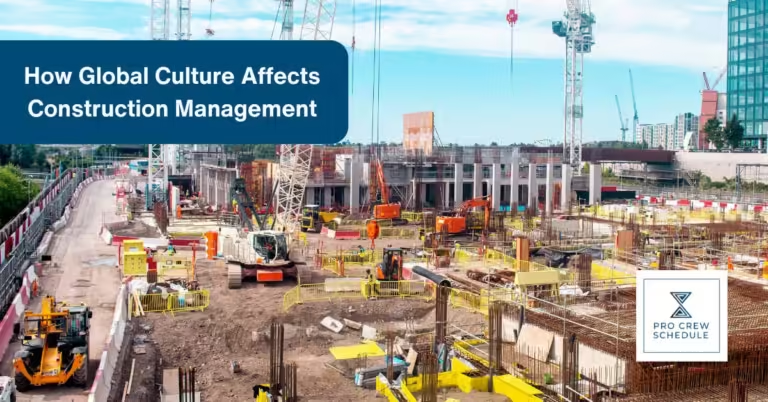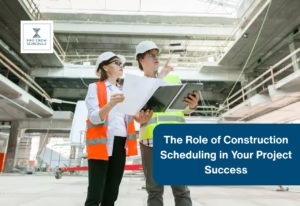Construction isn’t just about building structures; it’s a reflection of the cultures and practices of different regions.
Ever wondered how construction management differs across the globe? Let’s explore how various parts of the world handle their construction projects, their most famous infrastructure to date, and how you can adapt some of their systems.
Middle East
The Middle East is known for its high-profile projects and opulent designs. Cities like Dubai are famous for their architectural marvels and smart buildings. Construction management often integrates the latest technology to create luxurious, cutting-edge projects. It’s about combining grandeur with innovation, ensuring every detail is stunning and functional.
The Middle East is known for its stunning, luxurious buildings and cutting-edge technology. Cities like Dubai and Abu Dhabi are famous for their iconic skyscrapers and smart buildings. Construction here often combines grandeur with the latest in building tech.
Luxury Designs:
- Iconic Architecture: Think skyscrapers and lavish designs. The Middle East is home to breathtaking buildings combining high-end materials and innovative designs.
- High-End Materials: These projects often feature top-notch materials that make a lasting impression. By utilizing construction inventory management software, builders can keep a detailed record of these materials, manage their availability, and coordinate deliveries to ensure that the construction process remains smooth and uninterrupted.
Smart Systems:
- Building Management Systems (BMS): These systems control everything from lighting to security, making buildings more efficient and comfortable.
- Sustainable Technologies: To reduce environmental impact, solar panels, energy-efficient systems, and water recycling technologies are integrated.
High-Profile Projects:
- Global Collaboration: Managing these iconic projects often involves teams worldwide, ensuring that every aspect meets the highest standards.
- Famous Project
Burj Khalifa (Dubai): Although not in the U.S., it’s worth noting that the Burj Khalifa, famous for its title as the world’s tallest building, is often associated with American architecture due to the design input from the architectural firm Adrian Smith + Gordon Gill Architecture. Standing at 828 meters (2,717 feet), this skyscraper is an icon of modern architecture and engineering.
North America
In North America, especially in the U.S. and Canada, construction management is about high-tech solutions and top-notch safety. Think of it like the tech hub of the construction world. Building Information Modeling (BIM) is a big deal, making planning and executing projects easier. With strict regulations from OSHA (Occupational Safety and Health Administration), it’s a major priority to ensure everyone goes home safe at the end of the day.
Tech Integration:
- BIM (Building Information Modeling): Imagine having a 3D model of your building project that helps you spot issues before they become problems. BIM makes planning and coordinating a breeze by allowing everyone to see the project in detail.
- AI and Machine Learning: AI can predict potential delays and manage risks by analyzing data from past projects. It’s like having a crystal ball that helps you stay ahead of problems.
Safety First:
- Strict Regulations: Safety is a top priority in the U.S. and Canada. OSHA standards mean regular site checks, safety training, and ensuring everyone wears protective gear.
- Safety Culture:It’s not just about following rules; it’s about fostering a culture where safety is ingrained in everything. This includes continuous training and promoting safe practices on-site.
Software Savvy:
- Project Management Tools: Construction crew management software like Pro Crew Schedule helps with everything from task management to scheduling. It keeps everyone on the same page and makes project management more efficient.
- Famous Project:
CN Tower (Toronto): Completed in 1976, the CN Tower was the world’s tallest free-standing structure until 2009. At 553 meters (1,815 feet), it features an observation deck and a revolving restaurant that offers breathtaking views of Toronto and beyond.
Asia
Asia is a whirlwind of rapid development and innovative construction techniques. In places like China and India, skyscrapers go up at lightning speed, and prefabricated buildings are rising to keep up with the demand. On the other hand, Japan is all about precision, especially regarding earthquake-resistant designs.
Prefabrication:
- Modular Construction: Prefab buildings are a game changer. They’re assembled in a factory and then assembled on-site, speeding up the building process and reducing waste.
- Lean Construction: Techniques like Just-In-Time (JIT) delivery cut down on on-site material storage and streamline processes.
Seismic Design:
- Base Isolation: In places like Japan, buildings are designed to withstand earthquakes using base isolation techniques. This separates the building from ground movements to minimize damage.
- Structural Reinforcement: Advanced materials and designs, like reinforced concrete and steel frames, are used to make structures more resilient against seismic activity.
Fast Track:
- Accelerated Project Delivery: Projects can be completed faster by overlapping design and construction phases, which are crucial in fast-growing urban areas. This approach often involves sophisticated construction crew scheduling to ensure that different teams work harmoniously and that all project phases proceed smoothly. Effective scheduling ensures that labor is efficiently allocated, avoiding delays and keeping a project on track.
- Famous Project
Tokyo Skytree (Tokyo): Completed in 2012, it is the tallest structure in Japan and the second tallest in the world. At 634 meters (2,080 feet), it serves as a broadcasting, restaurant, and observation tower and is a modern symbol of Tokyo’s innovation.
Europe
Europe is like the green thumb of construction. Sustainability is a big focus, with many countries aiming for eco-friendly buildings and energy efficiency. Plus, Europeans take their historical buildings seriously. Renovations and new builds must respect and preserve the old while integrating modern needs.
Sustainable Construction:
- Green Building Certifications: Europe loves eco-friendly certifications like LEED and BREEAM. These guidelines help ensure buildings are energy-efficient and kind to the environment.
- Energy Efficiency: Think of solar panels, high-performance insulation, and smart HVAC systems. Europe uses these technologies to reduce energy use and carbon footprints.
Historical Care:
- Restoration Guidelines: Preserving historic buildings is a big deal. Restoration follows strict guidelines to maintain the building’s historical charm while adding modern conveniences.
- Heritage Impact Assessments: Before tackling renovations, impact assessments are conducted to understand how changes might affect the building’s historical significance.
Collaborative Approach:
- Integrated Project Delivery (IPD): This method brings everyone together—architects, engineers, and contractors. It helps tackle challenges collaboratively and ensures that all viewpoints are considered.
- Famous Project:
Sagrada Família (Barcelona): Designed by architect Antoni Gaudí, this basilica has been under construction since 1882. Known for its intricate, nature-inspired architecture and ongoing construction, it’s a UNESCO World Heritage Site symbol of Catalan modernism.
South America
In South America, construction often has to be resourceful and community-minded. With varying budgets and resources, local materials and creative solutions come into play. Plus, there’s a strong focus on projects that benefit local communities and address regional needs.
Resourcefulness:
- Local Materials: Using materials like bamboo or adobe helps manage costs and supports the local economy. It’s a smart way to make the most of what’s available.
- Innovative Techniques: Builders adapt traditional methods and combine them with modern solutions to address budget constraints and local needs.
Community Focus:
- Participatory Design: Engaging local communities in the design process ensures that projects meet their needs and are supported by those who will use them.
- Social Impact: Projects often aim to address social issues, such as creating affordable housing or community facilities.
Adaptability:
- Flexible Design: Buildings are designed to be adaptable, allowing for changes and repurposing as needs evolve.
- Famous Project
Gran Torre Santiago (Santiago):Completed in 2014, it’s the tallest building in Latin America. Standing at 300 meters (984 feet), it’s a modern landmark representing Santiago’s growth and economic development.
Africa
In Africa, construction management faces challenges like infrastructure gaps and resource limitations. However, there’s a growing focus on sustainable development and creative solutions to tackle these issues. Projects often aim to boost infrastructure and embrace innovative practices.
Infrastructure Development:
- Essential Projects: The focus is on critical infrastructure, such as roads and bridges, which are crucial for development and improving quality of life.
- Community-Based Projects: Projects often involve local communities in planning, ensuring they are relevant and beneficial.
Sustainable Practices:
- Green Building: Techniques like rainwater harvesting and solar energy are rising, helping address environmental and resource challenges. Alongside these, maintaining a well-organized material schedule in construction ensures that eco-friendly materials are used efficiently, reducing waste and supporting sustainability goals.
- Low-Cost Innovations: Building methods like earthbag construction offer cost-effective solutions to material shortages and affordability issues.
Creative Approaches:
- Local Expertise: Leveraging local knowledge helps develop practical and effective solutions to construction challenges.
- Partnerships: Collaborating with international organizations and NGOs provides additional resources and expertise.
- Famous Project
The Great Pyramid of Giza (Egypt): Constructed around 2580–2560 BC, it is the oldest of the Seven Wonders of the Ancient World and the only one still largely intact. With its precise construction and massive scale, the Great Pyramid remains one of the most enduring symbols of ancient Egypt and an architectural marvel.
Key Takeaway
As we’ve seen, construction management varies widely across the globe. Each region has its flavor, from North America’s tech-driven practices to Europe’s eco-conscious and historical approaches. Asia’s rapid development, the Middle East’s luxury, South America’s resourcefulness, and Africa’s innovation contribute to a rich, diverse construction landscape.
One tool that’s making a significant impact across these regions is construction crew scheduling software. This software helps streamline project management by efficiently allocating labor, managing shifts, and tracking crew availability, ensuring that projects stay on planned schedule and within budget.
Understanding these differences broadens our perspective and helps us appreciate the unique challenges and solutions each region brings. So, next time you look at a building, think about the global journey it might represent.







